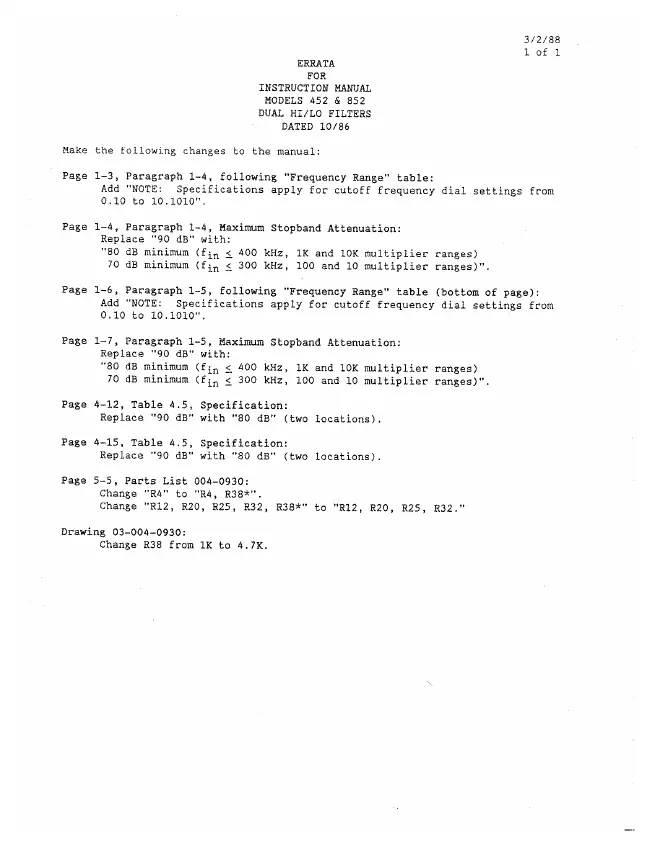Wavetek - 852 - Other
Manufacturer:

Image 1 of 1
If you have any other photos or manuals for the
Wavetek 852
you can
upload the files here.
Equipment:
852
Date:
1986
Category:
Group:
Sub Group:
Information
INTRODUCTION
The Models 452 and 852 are versatile dual-channel filters
consisting of two identical channels in a common cabinet.
Each filter channel has separate input/output terminals,
offers high pass and low pass functions, 0 dB and 20 dB
gain, Butterworth and Linear Phase responses and 3~digit
resolution for cutoff frequency selection.
Individual channels may be readily interconnected for series
or parallel operation, resulting in bandpass (or doubled
rolloff) and band reject functions respectively.
Each filter channel provides switch selectable Flat
Amplitude (Butterworth) response and Flat Delay (Linear
Phase) response.
The Butterworth filter has maximally-flat amplitude response
suitable for frequency-domain applications. Its cutoff
frequency (fc) is defined as the frequency at which the
amplitude response is down 3 dB.
The Linear Phase filter approximates a constant time delay
for frequencies below its cutoff frequency. This filter is
suitable for time-domain applications because of its
inherent ability to pass transient waveforms with a very
small amount of distortion and overshoot.
Models 452 and 852 are electrically and mechanically
similar, covering the cut off frequency range of 0.1 Hz to
111 KHz. Rol loff of the Model 452 is 24 dB/ octave/channel,
Model 852 is 48 dB/octave/channel. Factory installed Option
-01 extends cut off frequency range and resolution on both
models to 0.01 Hz.
Frequency-determining passive elements of the filters
consist of stable precision metal film resistors and close
tolerance polycarbonate or mica film capacitors.
The active elements are FET-input IC operational amplifiers
which provide highly stable gain, and very low noise and
distortion. This combination of active and passive elements
produces a filter having high cut off frequency accuracy and
resettability, and excellent temperature and long term
stability. Another result of precise control of
frequency-determining elements is close amplitude and phase
match between channels.
ELECTRICAL. Models 452 and 852 operate from either 115 or
230 volts ac,
50-500 Hz, and consume less than 5 watts of power. A
rear-panel slide switch selects the nominal line voltage.
The case of the instrument is grounded through the power
cord, but signal ground can be isolated from power ground
(through a 0.01 µf capacitor) via a rear-panel slide switch.
Cutoff frequency of each channel is selected via three 11
-position (0-10) switches and a 4-position multiplier
switch* The two pilot lights also serve as cutoff frequency
decimal point indicators. Passband Gain of 0 dB or 20 dB may
be selected for each channel. High Pass or Low Pass mode is
individually selectable for each channel, as well as Fiat
Amplitude or Flat Delay response.
MECHANICAL. The instrument cabinet is 3.5 inches high by 17
inches wide (1 9 inches wide including rack mounts). It is
13 inches deep and weighs 1 0 pounds (Model 452) or 12
pounds (Model 852).
The power switch, operating controls, and input and output
terminals are located on the front panel. The rear panel
contains duplicate (parallel) input and output terminals for
each channel, power connector, the fuse holder, the 115/230
Vac line selector switch, and a switch to disconnect signal
ground from the power ground.
In its standard configuration the instrument is supplied in
a cabinet suitable for table-top use, with feet and
tiltstand, A rack-mount configuration is also available (See
Options).
1 Manual
Service and user manual
Manual type:
Service and user manual
Pages:
73
Size:
2.0 MB
Language:
english
Revision:
Manual-ID:
Date:
October 1986
Quality:
Scanned document, reading partly badly, partly not readable.
Upload date:
Aug. 15, 2018
MD5:
f511e5ca-272e-dfbb-c23d-4c6a72b711f8
Downloads:
621
